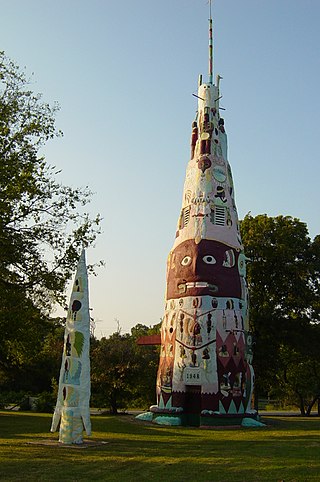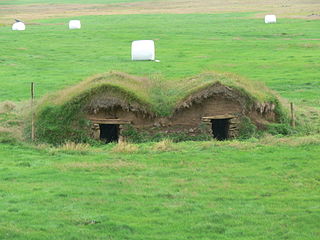
Cleo Springs is a town in Major County, Oklahoma, United States. The population was 287 at the time of the 2020 Census.

A dugout or dug-out, also known as a pit-house or earth lodge, is a shelter for humans or domesticated animals and livestock based on a hole or depression dug into the ground. Dugouts can be fully recessed into the earth, with a flat roof covered by ground, or dug into a hillside. They can also be semi-recessed, with a constructed wood or sod roof standing out. These structures are one of the most ancient types of human housing known to archaeologists, and the same methods have evolved into modern "earth shelter" technology.

Ed Galloway's Totem Pole Park consists of eleven objects and one building on 14 acres in Rogers County, in northeastern Oklahoma. The park is ten miles (16 km) north-east of Claremore and is located 3.5 miles (6 km) east of historic U.S. Route 66 and Foyil. It was added to the National Register of Historic Places on March 30, 1999. The park is now owned and operated by the Rogers County Historical Society. The park's main totem pole is billed as the "World’s Largest Concrete Totem Pole."

Newstead House is Brisbane's oldest surviving residence and is located on the Breakfast Creek bank of the Brisbane River, in the northern Brisbane suburb of Newstead, in Queensland, Australia. Built as a small cottage in the Colonial-Georgian style in 1846, the cottage was extended and today is painted and furnished in a late Victorian style.

The sod house or soddy was an often used alternative to the log cabin during frontier settlement of the Great Plains of Canada and the United States in the 1800s and early 1900s. Primarily used at first for animal shelters, corrals, and fences, if the prairie lacked standard building materials such as wood or stone, sod from thickly-rooted prairie grass was abundant, free, and could be used for house construction. Prairie grass has a much thicker, tougher root structure than a modern lawn.

Fort Gibson is a historic military site next to the modern city of Fort Gibson, in Muskogee County Oklahoma. It guarded the American frontier in Indian Territory from 1824 to 1888. When it was constructed, the fort was farther west than any other military post in the United States. It formed part of the north–south chain of forts that was intended to maintain peace on the frontier of the American West and to protect the southwestern border of the Louisiana Purchase. The fort succeeded in its peacekeeping mission for more than 50 years, as no massacres or battles occurred there.

The Chateau de Mores in Medora, North Dakota, United States, is a historic home built by the Marquis de Mores in 1883 as a hunting lodge and summer home for his family and guests. The home is now part of the 128-acre (0.52 km2) Chateau de Mores State Historic Site, which also includes Chimney Park and de Mores Memorial Park.

Sequoyah's Cabin is a log cabin and historic site off Oklahoma State Highway 101 near Akins, Oklahoma. It was the home between 1829 and 1844 of the Cherokee Indian Sequoyah, who in 1821 created a written language for the Cherokee Nation. The cabin and surrounding park was declared a National Historic Landmark in 1965 and is now owned by the Cherokee Nation.

William Scarbrough House is a historic house in Savannah, Georgia. Built in 1819, and subjected to a number later alterations, it is nationally significant as an early example of Greek Revival architecture, and is one of the few surviving American works of architect William Jay. The house was declared a National Historic Landmark in 1973. It is now home to the Ships of the Sea Maritime Museum, and it has largely been restored to an early 19th-century appearance.

The Cottonwood Ranch is a historic site near Studley in Valley Township, Sheridan County, Kansas, United States. The ranch is now preserved as a Kansas State Historic Site.

The Sod House Ranch is a historic ranch in Harney County in southeastern Oregon, United States. The remaining ranch structures are located south of Malheur Lake in the Malheur National Wildlife Refuge. The ranch was built by Peter French, a well known 19th-century cattle baron. The Sod House Ranch became the headquarters for the northern operating division of the French-Glenn Livestock Company, which eventually covered over 140,000 acres (570 km2). After French was murdered in 1897, the French-Glenn Livestock Company slowly sold off its ranch property. In 1935, the United States Government purchased the Sod House Ranch property to add to an adjacent wildlife refuge. The eight remaining Sod House Ranch buildings are now listed on the National Register of Historic Places.

The Pioneer Sod House, now known as the Wheat Ridge Museum and Sod House in Wheat Ridge, Colorado is a sod house built in 1886 or perhaps well before. It was listed on the National Register of Historic Places in 1973.

The Wallace W. Waterman Sod House near Big Springs, Nebraska, United States, is a sod house built in 1886. It was modified in 1925 for continued use, including a layer of concrete being applied to the exterior walls. It was listed on the U.S. National Register of Historic Places in 1995. The listing included two contributing buildings, the second being a small outbuilding from 1925.

The William R. Dowse House, more commonly known as the Dowse Sod House, is a sod house in Custer County in the central portion of the state of Nebraska, in the Great Plains region of the United States. It was built in 1900 and occupied until 1959. After a long period of neglect, it was restored beginning in about 1981, and opened as a museum in 1982.

Los Nogales is a historic 1800s home, among the oldest structures still standing in Seguin, Texas and is the last remaining adobe constructed home in the city. It serves the community as a museum.
The Page Soddy, in Harper County, Oklahoma southeast of Buffalo, Oklahoma, is a sod house built in 1902. It was listed on the National Register of Historic Places in 1983.

















